
Social Security and Medicare Funding Status
Social Security and Medicare are very important programs. Social Security provides monthly income that grows with inflation for as long retirees live. Medicare provides health coverage during potentially vulnerable times. For those wondering if the programs will be around when they retire, the answer is yes, but benefits may be reduced and/or additional taxes required. Corrective action is long overdue. This post will provide a financial overview of these programs in a Q&A format.
Summary
I provide a few bullet points and two graphs for those who want a quick summary. Following that are more details in an easy to consume Q&A format for more context and understanding of these very important programs. In summary, Social Security (OASDI) Trust funds run out three quarters sooner than last year’s estimate while Medicare Hospital Insurance runs out three years sooner, and the year when Medicare expenses as % of GDP exceeds 6% arrives about 15 years sooner, in early 2040’s. The Medicare portion covering doctor visits and drugs does NOT have a Trust fund so not projected to hit $0 but premiums will likely continue to increase.
- Social Security (Old-Age, Survivors, Disability) can cover 100% of promised benefits to year 2034, then only cover 81% of promised benefits.
- Stand-alone Old-Age and Survivors Trust fund runs short in 2033, then only covers 77%.
- Worsened primarily due to Social Security Fairness Act (repealed GPO, WEP offsets)
- Medicare Part A can cover 100% to year 2033, then 89% of promised benefits.
- Worsened primarily due to upward revision in expected expenditures in near term.
- Medicare Part B and D is fully funded since financed by premiums and general tax revenue – but % required from general revenue is growing quickly.
- Cost as % of GDP continues to increase due to higher projected spending for outpatient hospital and physician-administered drugs.
- Total Medicare cost currently just under 4% of GDP
- Was about 2% in mid-1990’s and projected to be above 6% just after 2040, much sooner than last year’s projections when didn’t hit 6% of GDP until after 2060
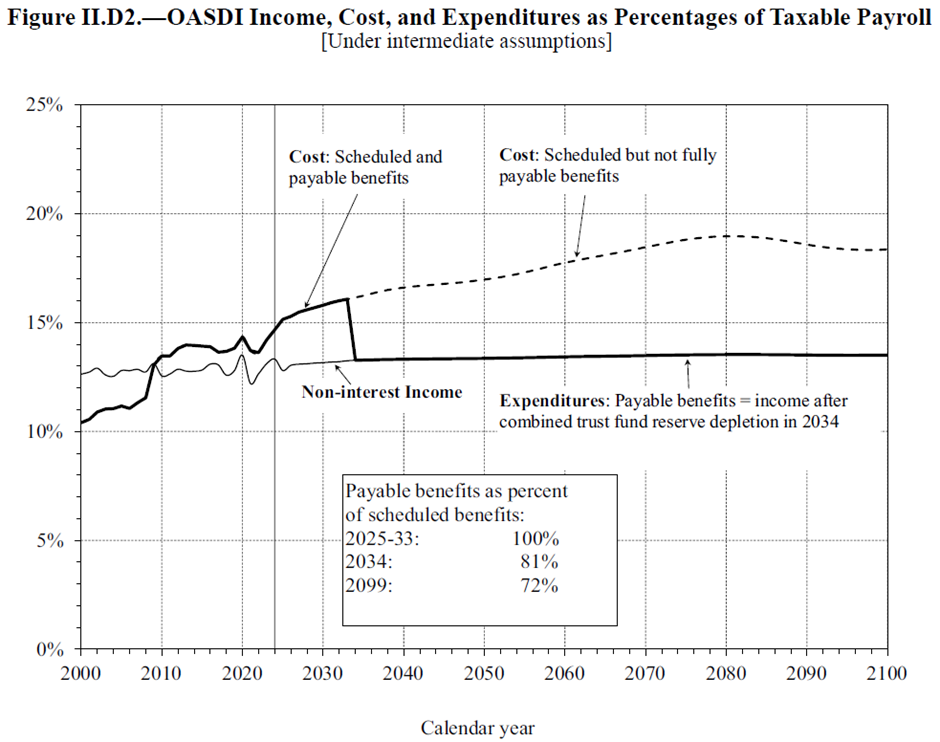
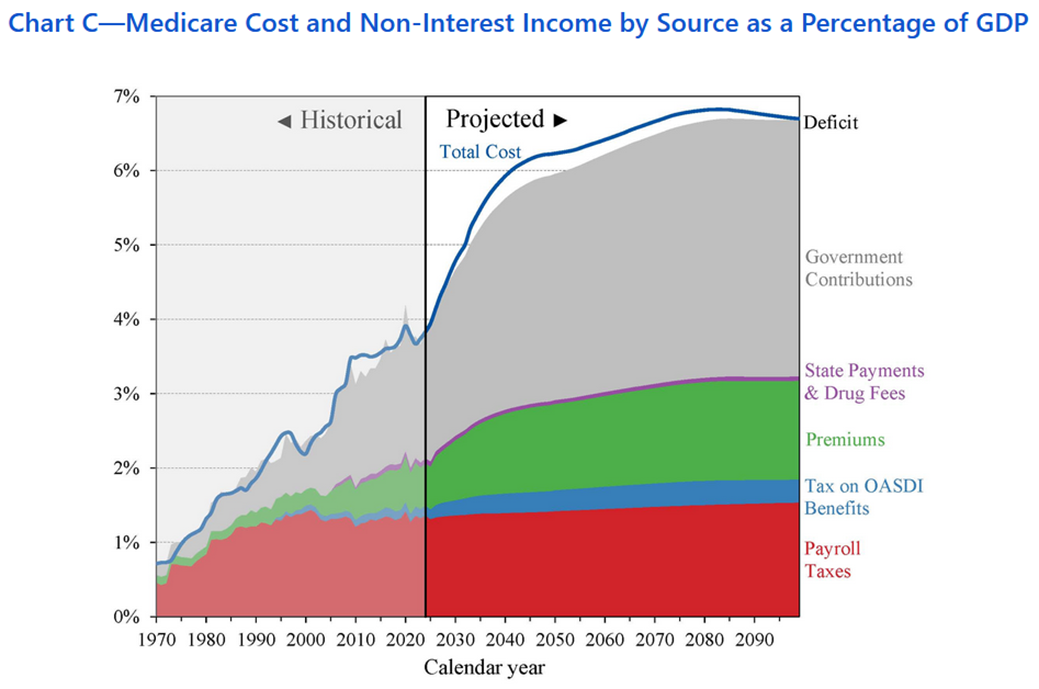
Before I begin with the Q&A details, there are three important documents I encourage you to become familiar with:
- Social Security Statement – available at https://www.ssa.gov/myaccount/ - provides an estimate of your monthly benefit based on earnings history. Annual mailing of statements stopped in 2011 (may receive in mail if over age 60 and not registered online).
- A Summary of the 2025 Annual Reports – available at https://www.ssa.gov/OACT/TRSUM/index.html - provides an executive summary with more graphics and highlights some additional topics.
- Annual Trustee Report – available at https://www.ssa.gov/OACT/TR/2025/tr2025.pdf - shows the financial health of both programs and actuarial projections. The latest report was released June 18, 2025 with useful information and the main source for this blog, both the Summary and Trustees Report (282 pages) for those who want details!
Q1 - What programs are included in Social Security and Medicare and what is funding status?
Social Security and Medicare are social insurance programs that provide benefits for individuals or family members for those workers who satisfy the number of years worked (and paid taxes) requirement. There are two programs under Social Security and two under Medicare, each with their own Trust Fund and financial status, though it is common to refer to them as simply two programs.
Social Security (OASDI)
- Old-Age and Survivors Insurance (OASI) – pays retirees and survivors
- Benefits covered 100% to 2033, then 77%
- Past Trends - ’24 – 2033, 79%; ’23 – 2033, 77%; ’22 - 2034, 77%
- Disability Insurance (DI) – pays those unable to work due to disability
- Benefits covered 100% over next 75-year projection period (same as recent past)
- NOTE: combined OASDI 100% covered to 2034, then 81%
- Past Trends - ’24 - 2035, 83%; ’23 - 2034, 80%; ’22 - 2035, 80%
- Key trend driver in 2025 due to Social Security Fairness Act, which repealed GPO, WEP offsets to benefits for some public service workers; this increased benefits without having been fully funded with past FICA taxes
Medicare (Part A, B, D)
- Hospital Insurance (HI) – Medicare Part A (inpatient hospital care)
- Benefits covered 100% to 2033, then 89%
- Past Trends - ’24 - 2036, 89%; ’23 - 2031, 89%; ’22 - 2028, 90%
- Key trend drivers in 2025: primarily due to an upward revision in expected expenditures in the near term, along with a higher starting base level due to 2024 expenditures also being higher than Trustees had anticipated last year.
- Supplemental Medical Insurance (SMI) – Medicare Part B (physicians, outpatient care) and Medicare Part D (prescription drugs)
- Benefits covered 100% into future; just raise premiums and grab more tax revenue
- NONE of the FICA tax paid over the years covers this portion of Medicare
- 23% of full cost covered my Medicare premiums you pay
- 73% of full cost covered by general revenue from taxpayers
Q2 - Who pays for Social Security and Medicare?
You do – either from payroll tax or general tax revenue, plus direct premiums if on Medicare. Current workers contribute a portion of their paycheck for the three programs in table below - sometimes called “payroll tax” or “FICA tax”. Your employer also pays the same tax; the self-employed pay the full 15.3%. The 6.20% OASDI tax applies to income up to $176,100 (for 2025) but the 1.45% Medicare tax is paid on all income. There is an additional 0.9% Medicare tax for the employee on earnings above $200,000 for individuals and $250,000 for joint filers that started in 2013 to help fund part of Affordable Care Act (not shown in table below). Also note the $200k and $250k is NOT indexed for inflation, catching more workers each year with wage inflation.


Medicare Part B and Part D is funded primarily from two sources – about 73% comes from general revenue of our generous taxpayers, 23% comes from monthly premiums by retirees and the remaining 4% from other sources. That’s right – the monthly Medicare premiums only covers about 23% of the true cost. Medicare Part B monthly premium = $185.00/month; Part D base premium varies by plan depending on specific drug coverage you select. Additional tiered premiums for Part B and D are required for high income retirees (in 2025 – if Modified Adjusted Gross Income above $106,000 for individual filers; $212,000 for joint filers – more details later).
Q3 - Does each worker have their own account where the payroll taxes go until they retire?
No. Unlike your 401k account or savings account, Social Security and Medicare Part A use “pay-as-you-go funding”. This means payroll taxes collected by current workers are used to pay the bills for existing retirees. When existing workers retire, the next generation of workers will be paying their bills. Yes, the number of workers relative to the number of retirees changes over time and impacts the financing. The Social Security and Medicare actuaries project the expected financial impact on these changing demographics, but the tough part is convincing politicians and the public to make the tough choices now to assure long-term funding.
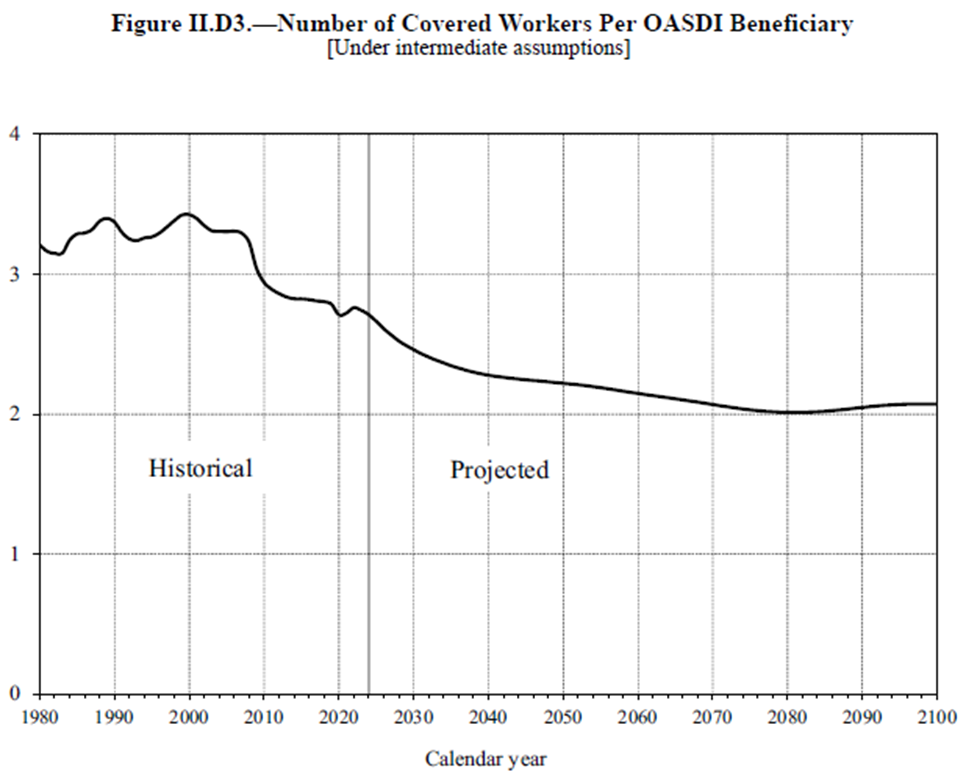
Q4 - What happens to the extra payroll tax not needed to pay current benefits?
This is where the Trust Funds come in. Earlier when incoming payroll tax exceeded outgoing benefits, the excess was earmarked into Trust Funds and invested in Treasuries (non-marketable securities – so only a bookkeeping entry). Later when payroll tax revenue was lower than outgoing benefits (which has occurred since 2010) the difference was made up by drawing down the Trust Funds. Technically the Trust Funds are simply IOU’s from the government but that is a separate, complex topic. It is the year these Trust Funds are projected to go to $0 and the % of promised benefits covered thereafter that summarizes the health of the programs (refer to intro).
Q5 - So how soon will the Trust Funds hit $0? Then what happens?
Very soon! The Old-Age and Survivors Insurance (OASI) Trust Fund is projected to hit $0 in 2033 at which time only current payroll tax will be available to pay 77% of promised benefits. If combined with the Disability Insurance (OASDI) Trust Fund (would require Congress to act), funds will be depleted in 2034 and then cover 81% of promised benefits. Medicare Hospital Insurance Trust Fund (Part A) is projected to run out in 2033 when current payroll tax is projected to cover 89% of promised benefits. Where is the Trust Fund for Medicare Supplementary Medical Insurance (Part B and D) you ask? It is never projected to be depleted since financing the SMI is set to meet expected costs, again roughly 23% from increasing Medicare premiums, 73% from taxpayer generosity and remaining 4% from various sources (see table in next section).
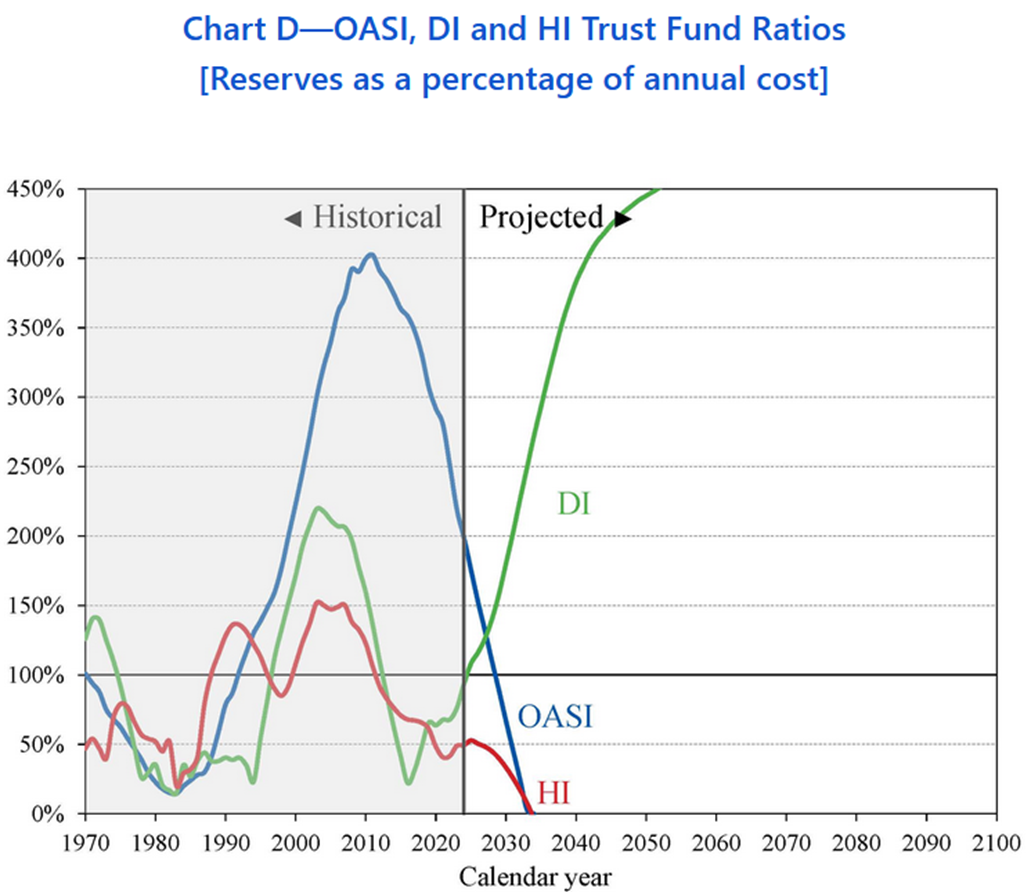
Q6 - Wait a minute. Tell me about Medicare funding again?
Only the Hospital Insurance (Part A) is funded by payroll taxes (see red area in graph below). The Supplementary Medical Insurance (Part B and D) has about 25% funding from Medicare premiums (green area) and most of the other 75% from general taxing revenue (grey area) and taxes on Social Security benefits (blue area). That is why Medicare Part B premiums seem so reasonable – it only reflect about 25% of the true cost. What is staggering is the projected cost as a % of GDP for the overall program – going from 2% in mid-90’s to about 4% today and surpassing 6% in less than 20 years! Last year’s projections didn’t surpass 6% until about 15 years beyond this point, around 2060.
The majority of that expanded cost is projected to be covered by general tax revenue based on current law – not payroll taxes or dedicated premiums. In fact, the law requires Trustees to trigger a “Medicare funding warning” if general revenue is projected to exceed more than 45% of total projected costs in any of the next seven years. This has happened for NINE consecutive years. The President must submit proposed legislation to Congress to respond to the warning “on an expedited basis”. I mentioned nine consecutive years, right?
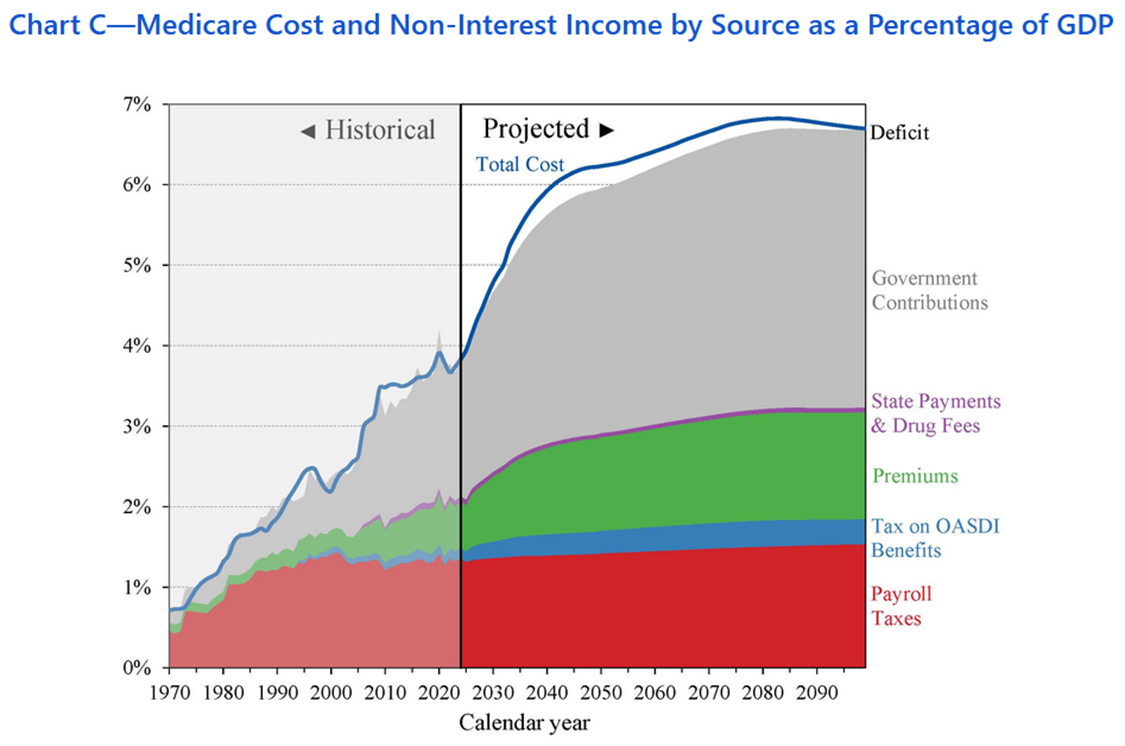
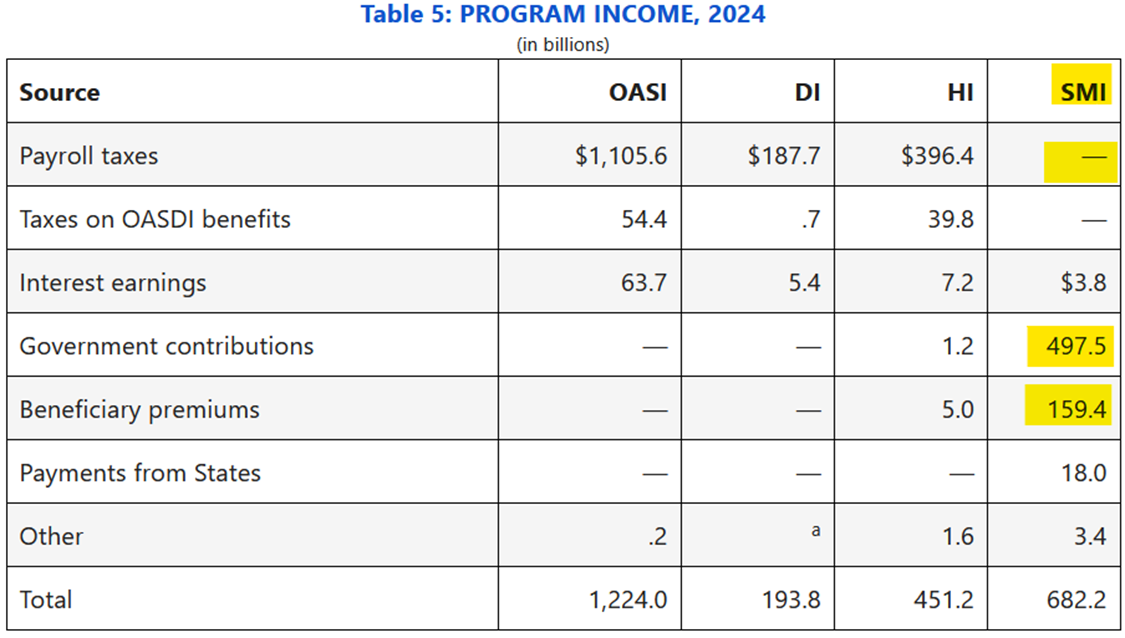
Q7 - Interesting. Can you briefly explain each of those color bands again?
Note the chart covers both Medicare programs – Hospital Insurance (Part A) and Supplemental Medical Insurance (Part B and D). The bills are paid as follows:
Payroll Taxes (red) – 1.45% FICA tax paid by current workers; plus 1.45% from employer
Premiums (green) – monthly Part B and D premiums once on Medicare; includes IRMAA (see later)
Government Contribution (gray) – money from us, the taxpayers, via general tax revenue; growing!
Tax on OASDI Benefits (blue) – ranges from 0% - 85% of SS benefits are taxable income based on ‘base income’ definition which is too convoluted to summarize here. Note the levels were set in 1983 and NOT adjusted for inflation, so it continues to catch more people at 85% of SS benefits to taxable income:
- Individual filer – 0% if < $25k; up to 50% between $25k - $34k; up to 85% > $34k
- Joint filers – 0% if < $32k; up to 50% between $32k - $44k; up to 85% > $44k
- Interestingly, tax revenue up to 50% of benefits goes to OASDI; rest goes to HI
State payments & Drug Fees (purple) – state contributions if an individual would have been on Medicaid if not for Medicare; not sure of drug fees
Q8 - You mentioned extra tiered premiums for Medicare Part B and D and IRMAA. What is this?
The 2025 premium for Medicare Part B is $185.00/month and Part D varies by plan based on drug coverage chosen. Due to Medicare financing concerns at the beginning of this century, the Medicare Modernization Act of 2003 introduced Income Related Monthly Adjustment Amounts (IRMAA) for Part B only and first implemented in 2007. It was expanded to Part D in 2010 to help fund Affordable Care Act. The bands and premium adjustments are set by Congress and have been changed over the years. IRMAA applies if Modified Adjusted Gross Income (based on tax return two years ago) is currently above $106k for single and $212k for joint filers. There are multiple tiers, reaching double the premium in the middle tier and 3.4x premium level at the highest tier. I would expect Congress will continue utilizing this mechanism to quietly increase financing for Medicare. NOTE: Part B IRMAA shows the total premium; Part D IRMAA shows additional amount above your plan premium since varies for each person based on drug exclusions selected.
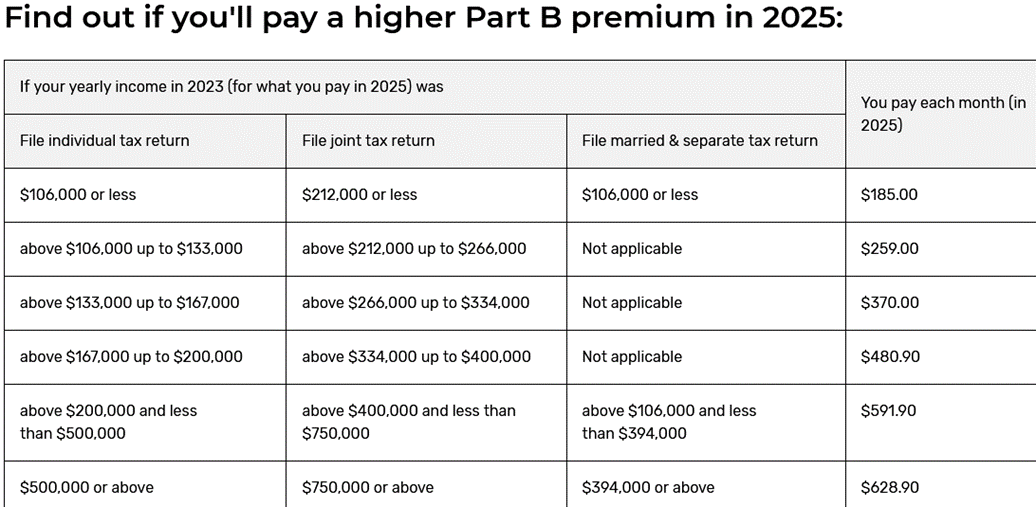
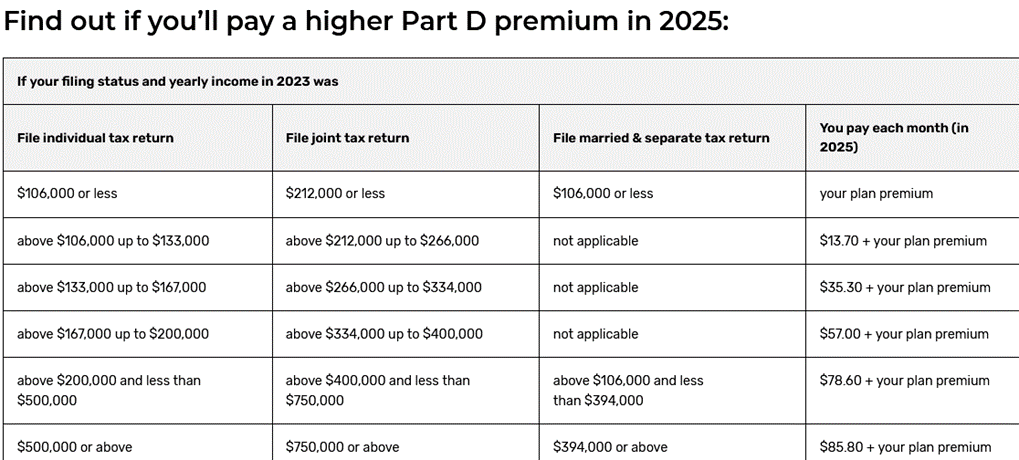
Q9 - So should I assume I will get nothing from Social Security?
No. I believe for those currently receiving benefits there will be no reduction. For younger workers, you will very likely get less than currently promised but it will be much closer to the promised benefit that it will be to $0. Remember Social Security is a pay-as-you-go system. After the Trust Funds are depleted there is still current payroll tax coming in to pay benefits. The graphic below shows that while there won’t be enough funds to pay the current promises, it will be enough to pay 81% starting in 2034 (using combined OASDI), then drifting down to 72% in 2099 and beyond. In reality, it will likely be some combination of lower benefits and higher taxes to avoid this cliff, though given the history, likely tilt toward more taxes.

Q10 - I’m in good health and my advisor keeps telling me to delay Social Security. My parents claimed SS at 65 so why shouldn’t I?

Because you are living longer and your benefit will be reduced by 13% for life if you claim at age 65 instead of full retirement age of 67 if born in 1960 or later (this age was 65 when program first started). Think of Social Security as an inflation-adjusted income payable for as long as you or your spouse are alive from a high-quality institution. For those born after 1960, delaying your benefit by just three years will increase this wonderful pension by 24%. Did I mention it also grows with inflation and is payable for life? Get some of that.
The table below shows life expectancy over time. The first two columns show life expectancy at birth; the last two show the expected remaining life expectancy for those who made it to age 65. Notice the increasing life expectancy, both historically and projections.
Q11 - Can’t they just raise payroll taxes to cover the shortfall?
Sure – but the combined rate is already quite high, and much higher than expected when the program began. One projection from 2023 to cover the Social Security shortfall is to increase OASDI payroll tax from 12.4% (6.2% x 2) to 16.0% (extra 3.6% of your income) starting now. In 2023, adding the 2.9% Medicare tax gets to 18.9% - almost one-fifth of payroll – to fund the ever-increasing benefits. The table below shows the historic OASDI and HI payroll tax rates since the mid-60’s. It is important to recall the original intent of Social Security was to keep individuals out of poverty, not to provide full retirement income for most Americans. It is difficult to make changes when the impact is so far down the road, but the day of reckoning is upon us. A healthy debate is needed about what % of total income should be forced into a government program that provides a necessary safety net to keep people out of poverty and leave the remaining amount in the hands of the individual.
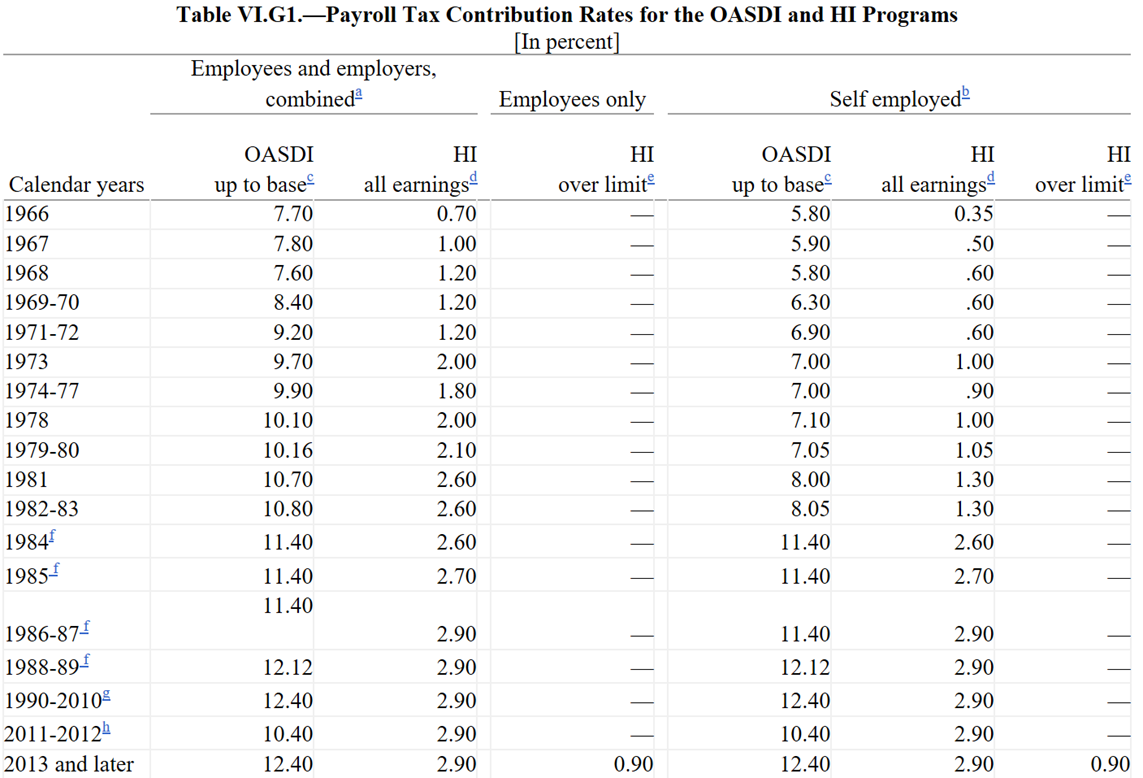
Q12 - Can’t they just raise taxes on the high income earners?
It is important to realize both Social Security and Medicare are already doing this in a few ways. Before adding even more progressive features, it is important to understand and acknowledge the built-in progressive elements of the program.
- Social Security uses “bend points” to calculate the benefit received. Everyone pays the same 6.2% FICA tax on income but the amount of benefit paid is based on 90% of first $1,226 in monthly earnings, then 32% on income between $1,226 - $7,391, and finally 15% above. This results in lower income workers receiving a much higher % of their income as a benefit. Keeping with the “social” part of the program and lifting individuals out of poverty makes sense. But it should be recognized that the benefit calculation is already quite progressive (see graph below).
- A portion of Social Security benefits is included in taxable income if ‘base income’ exceeds thresholds. See the earlier discussion. Recall these thresholds ARE NOT adjusted for inflation so it will continue to catch more people having to apply 85% of SS benefits to taxable income. Note $35,700 was the maximum wage limit for Social Security taxes in 1983 when these thresholds were set. That wage limit today adjusted for inflation is $176,100, so you can see the expanded pool of individuals now exposed to taxable SS benefits relative to when first passed. Also recall the recent extra 0.90% Medicare tax on earnings above $200k single and $250k joint is NOT indexed to inflation either.
- Medicare collects a higher monthly premium on high income beneficiaries by something called IRMAA. See the earlier discussion. Here is a link to the cost section of the Medicare website.
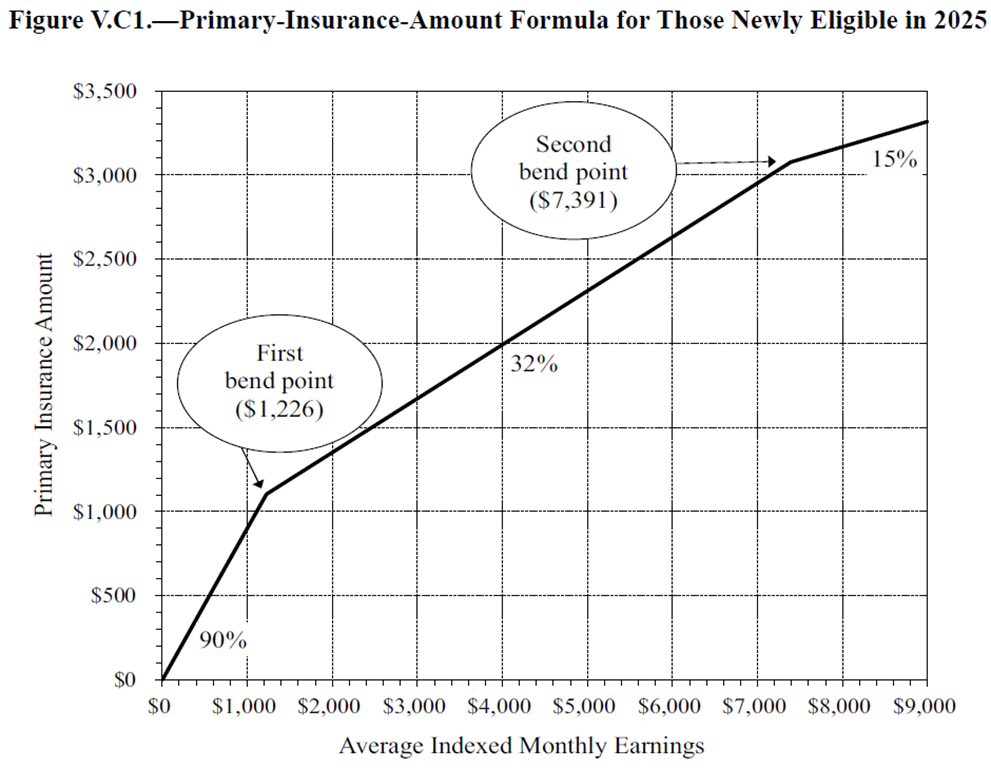
Q13 - What changes to Social Security are being considered and what is the impact on funding?
There are different changes being considered to the Social Security program. A summary of the changes and the financial impact to the program is summarized by the Office of the Chief Actuary and can be found here (with estimates based on the 2024 Trustees Report).
Potential changes range from the type of cost-of-living adjustments to “bend point” changes to extending the retirement age to reflect longer life expectancy. It will likely require some combination of these changes in order to assure long-term financial stability. Note these are only Social Security changes, not Medicare.
If you are still with me I hope this was helpful. It is important to be aware of the issue to not only help plan your retirement (don’t assume $0 Social Security benefit!) but also to engage in a thoughtful, well-informed debate about the best path forward for these important, yet financially troubled programs. I don’t believe they will change the benefits for those already or close to receiving benefits as I am reminded of a then Senator Rubio comment during a presidential debate years ago – “I’m against anything that’s bad for my mother.”
Have questions? Reach out! We're happy to help.
Posted by Kirk, a fee-only financial advisor who looks at your complete financial picture through the lens of a multi-disciplined, credentialed professional. www.pvwealthmgt.com

